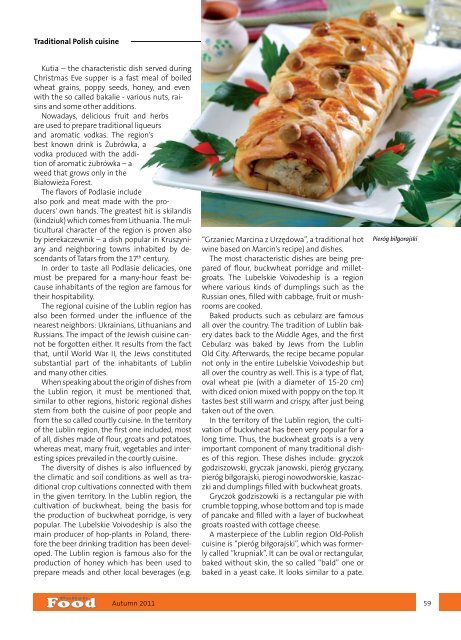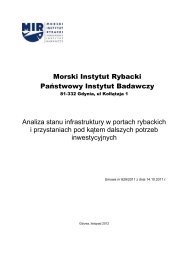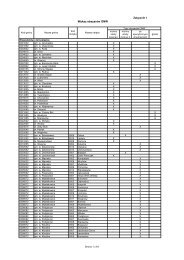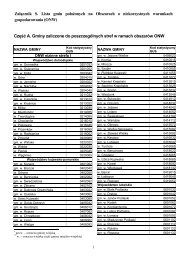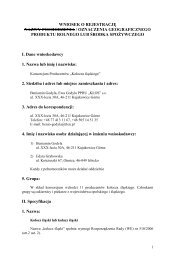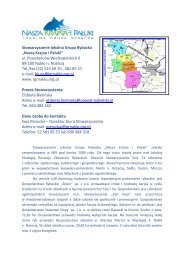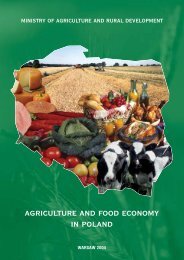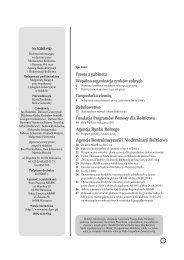download file
download file
download file
Create successful ePaper yourself
Turn your PDF publications into a flip-book with our unique Google optimized e-Paper software.
Traditional Polish cuisine<br />
Kutia – the characteristic dish served during<br />
Christmas Eve supper is a fast meal of boiled<br />
wheat grains, poppy seeds, honey, and even<br />
with the so called bakalie - various nuts, raisins<br />
and some other additions.<br />
Nowadays, delicious fruit and herbs<br />
are used to prepare traditional liqueurs<br />
and aromatic vodkas. The region's<br />
best known drink is Żubrówka, a<br />
vodka produced with the addition<br />
of aromatic żubrówka – a<br />
weed that grows only in the<br />
Białowieża Forest.<br />
The flavors of Podlasie include<br />
also pork and meat made with the producers'<br />
own hands. The greatest hit is skilandis<br />
(kindziuk) which comes from Lithuania. The multicultural<br />
character of the region is proven also<br />
by pierekaczewnik – a dish popular in Kruszyniany<br />
and neighboring towns inhabited by descendants<br />
of Tatars from the 17 th century.<br />
In order to taste all Podlasie delicacies, one<br />
must be prepared for a many-hour feast because<br />
inhabitants of the region are famous for<br />
their hospitability.<br />
The regional cuisine of the Lublin region has<br />
also been formed under the influence of the<br />
nearest neighbors: Ukrainians, Lithuanians and<br />
Russians. The impact of the Jewish cuisine cannot<br />
be forgotten either. It results from the fact<br />
that, until World War II, the Jews constituted<br />
substantial part of the inhabitants of Lublin<br />
and many other cities.<br />
When speaking about the origin of dishes from<br />
the Lublin region, it must be mentioned that,<br />
similar to other regions, historic regional dishes<br />
stem from both the cuisine of poor people and<br />
from the so called courtly cuisine. In the territory<br />
of the Lublin region, the first one included, most<br />
of all, dishes made of flour, groats and potatoes,<br />
whereas meat, many fruit, vegetables and interesting<br />
spices prevailed in the courtly cuisine.<br />
The diversity of dishes is also influenced by<br />
the climatic and soil conditions as well as traditional<br />
crop cultivations connected with them<br />
in the given territory. In the Lublin region, the<br />
cultivation of buckwheat, being the basis for<br />
the production of buckwheat porridge, is very<br />
popular. The Lubelskie Voivodeship is also the<br />
main producer of hop-plants in Poland, therefore<br />
the beer drinking tradition has been developed.<br />
The Lublin region is famous also for the<br />
production of honey which has been used to<br />
prepare meads and other local beverages (e.g.<br />
“Grzaniec Marcina z Urzędowa”, a traditional hot<br />
wine based on Marcin's recipe) and dishes.<br />
The most characteristic dishes are being prepared<br />
of flour, buckwheat porridge and milletgroats.<br />
The Lubelskie Voivodeship is a region<br />
where various kinds of dumplings such as the<br />
Russian ones, filled with cabbage, fruit or mushrooms<br />
are cooked.<br />
Baked products such as cebularz are famous<br />
all over the country. The tradition of Lublin bakery<br />
dates back to the Middle Ages, and the first<br />
Cebularz was baked by Jews from the Lublin<br />
Old City. Afterwards, the recipe became popular<br />
not only in the entire Lubelskie Voivodeship but<br />
all over the country as well. This is a type of flat,<br />
oval wheat pie (with a diameter of 15-20 cm)<br />
with diced onion mixed with poppy on the top. It<br />
tastes best still warm and crispy, after just being<br />
taken out of the oven.<br />
In the territory of the Lublin region, the cultivation<br />
of buckwheat has been very popular for a<br />
long time. Thus, the buckwheat groats is a very<br />
important component of many traditional dishes<br />
of this region. These dishes include: gryczok<br />
godziszowski, gryczak janowski, pieróg gryczany,<br />
pieróg biłgorajski, pierogi nowodworskie, kaszaczki<br />
and dumplings filled with buckwheat groats.<br />
Gryczok godziszowki is a rectangular pie with<br />
crumble topping, whose bottom and top is made<br />
of pancake and filled with a layer of buckwheat<br />
groats roasted with cottage cheese.<br />
A masterpiece of the Lublin region Old-Polish<br />
cuisine is “pieróg biłgorajski”, which was formerly<br />
called “krupniak”. It can be oval or rectangular,<br />
baked without skin, the so called “bald” one or<br />
baked in a yeast cake. It looks similar to a pate.<br />
Pieróg biłgorajski<br />
Autumn 2011 59


